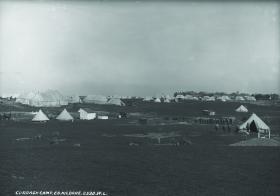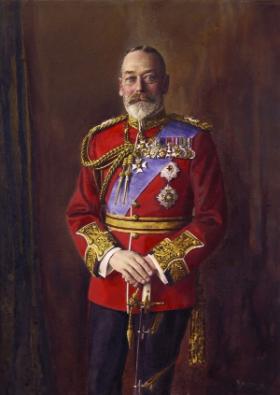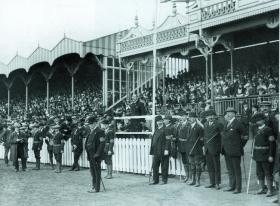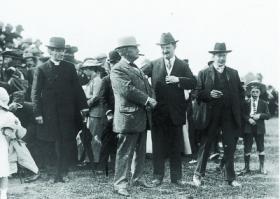Waiting for Home Rule in County Kildare
Published in 18th–19th - Century History, Features, Home Rule Crisis, Issue 6 (Nov/Dec 2006), Revolutionary Period 1912-23, The Act of Union, Volume 14
The Curragh camp—the British army was a major employer, so many Kildare families weren’t eager to sever all links with the empire. (National Library of Ireland)
The December election of 1910, which gave John Redmond’s Irish Parliamentary Party the balance of power, and the subsequent passing of the Parliament Act in 1911, which removed the House of Lords veto, made the prospect of Home Rule a very real possibility for Ireland. Like the rest of southern Ireland, Kildare awaited the imminent bill with great hope. An editorial in the Leinster Leader on 6 January 1912 captured the sense of anticipation:
‘The people of Ireland are not disposed to lose any undue time about entering into the luxury of their political star-turn this year. In two months time this country will jump to the eye of the world, and people who had forgotten that Ireland existed or who had come to the conclusion that we had disappeared and become a province of England will be once more aware that there is an island beyond an island with an extraordinary vitality and a claim to recognition as a nation.’
The majority of Kildare’s people were determined to see Home Rule become a reality and began to mobilise and organise themselves politically. Until this point apathy was rife at local government level in Kildare, as elsewhere, after the demoralising Parnell split. The prospect of a new Home Rule bill that could not be permanently blocked by the House of Lords injected great energy into local politics in Kildare. Those involved understood well that since one of the biggest arguments against Home Rule was the supposed inability of Ireland to govern itself, greater organisation at county council level would help Home Rule’s cause: ‘Now is the time to show that Irish people are meant to have home rule and land for the people’.
New branches of the United Irish League began springing up all over the county. One of the first to be founded was in Staplestown, Clane, Co. Kildare, in March 1912. County councillor P. Phelan was appointed president and was pleased to found ‘a good working branch which is badly needed in Kildare. The National Party are not supported in Kildare as they should be.’ Kildare local government threw itself fully behind John Redmond’s party and regularly passed motions endorsing his leadership.
Even the Kildare Observer, which tended more towards unionism, published glowing reports of Home Rule-related meetings. The week before the bill was announced the paper ran a report on a pro-Home Rule demonstration that had taken place in Dublin that week. It pronounced it ‘the greatest, the most orderly demonstration in favour of Home Rule that has ever taken place in the Irish capital’, and commented that ‘the grand and undeniable feature of the mighty throng was its complete orderliness and good behaviour’. A contingent from Kildare, including twenty representatives of the council, travelled to the demonstration to express Kildare’s support. The newspapers were filled with reports relating to Home Rule. Hardly a day went by when there was no mention of the bill, which goes some way towards suggesting the excitement the people felt about the new political development. The people of Kildare looked forward to ‘peace, prosperity and a golden era’ for Ireland as the rallying of generations of Irish people was about to, it seemed, come to fruition.

King George V—visited Maynooth in July 1911. (National Portrait Gallery)
The bill is announced
The bill was eventually presented by Asquith to the House of Commons on 11 April 1912 and was warmly welcomed by the vast majority of the people of Kildare. It was generally considered an excellent bill and more than enough to satisfy even the readers of the staunchly nationalist Leinster Leader. Nine days after it was introduced, the paper’s editorial was unreserved in its praise:
‘No man in his senses would advise the parliamentary leaders to reject the bill. It is, we believe, as good a bill as Ireland could ever hope, or can ever hope, to gain by parliamentary agitation’.
The same edition also carried expressions of support from public figures in Kildare. The bill was described variously as ‘excellent’, ‘splendid’ and ‘an honest attempt to do justice to Ireland’. Mr D. J. Doyle, chairman of Naas Urban District Council, said that ‘the bill was a good one, even better than generally expected’. It was also seen as an economically viable solution to the Irish question. Mr Mathew Minch, chairman of the County Council, ‘heartily approved of the bill which in its fiscal aspects contained everything essential for ultimate fiscal autonomy’. In terms of how much independence it offered, it was seen as more than acceptable: ‘The bill goes further than the most sanguine nationalist expected’. Possibly it was more acceptable in Kildare than other, more nationalist areas, as there was not the same level of anti-British sentiment in the county as elsewhere. This may have been due to the many garrison towns there, including Naas, Newbridge, Kildare and the barracks at the Curragh. The British army was a major employer, particularly for those from poorer backgrounds. Many Kildare families were provided with a steady income directly from the British and so weren’t eager to sever all links with the empire. In fact, less than a year before the bill was introduced, in July 1911, King George made a visit to Maynooth. Newspaper reports tell us that the locals welcomed the king, waving Union Jacks and singing ‘God Save the King’. In Maynooth College ‘the royal standard and the papal flag floated side by side’. In general, while Kildare was delighted at the prospect of Home Rule, it was by no means desperate for complete independence.
The Catholic clergy of Kildare were also in favour. At a United Irish League public meeting in Naas, chairperson Fr Norris stated that ‘it was almost impossible to conceive an Irishman whose heart didn’t gladden at the prospect’. Nevertheless, though it may have been difficult for some to believe, not everyone in Kildare welcomed the Home Rule bill with such enthusiasm.
Unionist opposition
To some in Kildare, Asquith’s announcement was the realisation not of a dream but of a nightmare. Kildare unionists described the bill as ‘a scorpion compared with the whips of 1886 and 1893’. In August 1913, unionists of County Kildare joined their voices with those of other Irish counties in protest against the Home Rule bill. A meeting was held at Palmerstown House to voice their concerns and to demonstrate that not everyone in the south of Ireland appreciated the bill. The chairman, the earl of Mayo, said that it was ‘most important that these meetings should be held in the south of Ireland, because there was an impression abroad in England that it was only in a corner of Ulster that there was a great fight going on’. The meeting was well attended, and the Kildare Observer reported that there were more people in the county who opposed Home Rule but who were ‘afraid to come forward to a public meeting’.

Sir Edward Carson addressing a parade of Ulster Volunteers in July 1913—nationalists in Kildare, as elsewhere, underestimated the strength of unionist opposition to Home Rule. (George Morrison)
Much of their opposition was based on economic grounds. If Home Rule went ahead, it was said, prosperity in Ireland would end entirely. The country would be crippled with taxes and would ‘stagnate, with no possible means of advancement’. More opposition came from a deep distrust of Redmond’s party. Those at the meeting expressed ‘a fear and dread of being ruled by such people … a disloyal party who encouraged disorder’. Although most of the attendees were wealthy landowners, the concern voiced was not just for their own interests but also for the well-being of Ireland in general. Mr Arthur Samuels KC expressed this when he said that they spoke against the bill ‘not as unionists, but as Irishmen and Irishwomen, who stood remote from politics, and were concerned only, as they all were, to secure the welfare of their native land’. Through the imposition of Irish taxes as well as British taxes Ireland would become the most expensive place in the kingdom to live. Those who could afford to would leave, and for those left behind the extra land taxes would ‘weigh exceedingly heavily upon the shoulders of the tenant farmers’. Ultimately, it was felt, ‘Home Rule meant ruin to the man and to the nation’. Unionist women of Kildare also voiced their opposition. The North Kildare branch of the Women’s Unionist Association met in Celbridge. They felt that they had to resist Home Rule since in the end it would determine ‘whether they were to be ruled by Pope Pius X or King George V’.
Many people failed to take seriously the threat posed by unionist opposition to the third Home Rule bill, including Redmond: ‘The magnitude of the peril of the Ulster situation is considerably exaggerated’. Asquith adopted a ‘wait and see’ attitude and looked to Redmond for advice on such matters. Part of the problem was ignorance. Those outside Ulster had very little understanding of how serious the unionists were. Police spied on nationalists, not unionists, giving them very little inside information, with the result that few foresaw the lengths to which unionists would go to resist Home Rule. The people of Kildare were no exception and for a long time seemed to see unionist resistance as a non-issue.
Even as far back as 1911 nationalists in Kildare were failing to take unionist threats seriously, despite explicit statements from unionists such as Bonar Law that ‘there are things stronger than parliamentary politics’ and the earl of Mayo’s promise to ‘use arguments stronger than mere resolutions’. The Leinster Leader considered these threats ‘hollow’. Kildare nationalists could not believe that a group who had for so long insisted on sticking to the letter of the law would now turn to violence, and pointed out the ridiculousness of unionists attacking the decision of the British government to whom they claimed to be loyal. The paper said that this would be ‘one of the greatest follies in modern times’. Interestingly, there seems to have been a really genuine belief among Kildare people that the unionists would be happy with the Home Rule bill. County councillor George Wolfe said that the bill contained ‘every reasonable protection for Protestants’ and that it ‘should satisfy Ulster people if anything will’.
At a United Irish League meeting in January 1912, the crowd dismissed the idea that ‘home rule would mean Rome rule’. As far as the people of Kildare were concerned, ‘the cry of intolerance was a false one’. They believed this on the basis of the ‘harmonious relations’ existing between the Catholic priests and pastors of the other churches in the locality. The argument of intolerance fell flat, they believed, ‘for it was against the nature of the Irish people to persecute for conscience sake’.
Unionist threats were treated with mockery and derision. A Mr O’Connor joked that ‘citizen-president Carson of the Armagh republic had threatened to march south’ but that he was unlikely to reach as far as Naas, a remark that was greeted with laughter from the crowd. This general refusal in Kildare to take seriously the Ulster threat was in keeping with the attitude in much of Ireland (and England).
Nationalist opinion radicalised by suspension

Irish Parliamentary Party leader John Redmond (with cigar)—Kildare local government threw itself fully behind Redmond’s party and regularly passed motions endorsing his leadership. (George Morrison)
Up to 1914 the nationalist reaction to Home Rule in Kildare had been very moderate. Intelligence notes from Dublin Castle reveal that Kildare was, for the most part, ‘peaceful, orderly and free from agrarian trouble’. Before the bill was suspended owing to war in Europe the Irish Volunteers had little support in Kildare. The county inspector of Kildare reported that there was no interest in Home Rule in County Kildare ‘until there was a doubt about the bill becoming law’. In May 1914, as it became increasingly likely that Home Rule would be postponed, Volunteer groups began drilling in Kildare and membership rose to 3,000. Units of the Irish Volunteers were organised in nearly every parish in the county during the early months of 1914, first in Naas, then in Athy and Monasterevin. So many people turned up to the initial meeting in Naas that there wasn’t enough room in the town hall. They had to move their meetings to an unused jail to accommodate the numbers attending the drills. On 7 June over 7,000 people gathered at the Curragh for what was described as ‘the greatest nationalist meeting seen for some time’. According to James Durney (On the one road: political unrest in Kildare 1913–1994), while a large part of the population of the county remained loyal to the Crown, 1914 and the suspension brought ‘a major revival of nationalist feeling in Kildare’. By August Volunteer support had risen to 6,000 in the county and a County Kildare committee for the Irish Volunteers was founded. It was clear that the suspension had made Kildare considerably less moderate in its support for Home Rule. While many Kildare men went on to fight for Britain in the Great War, others continued drilling and some fought in the 1916 Rising.
Conclusion
Historians often make assumptions about public opinion. According to Joe Lee, ‘We assumed for so long that we knew all about public opinion that we pronounced on it rather than studied it’. In Ireland 1912–1985: politics and society (1985) Lee tells us that ‘home rule was so limited that it required all the persuasive powers of home rule leader John Redmond to allay the chagrin of his followers’. In Kildare, however, it is clear that this was not the case. Local politicians supported Redmond unconditionally, and the people of Kildare, at least until 1914, showed nothing but enthusiasm for the bill. Given that just four years later nothing but complete independence would suffice for most nationalists, it is interesting to see how utterly content people were in Kildare with the prospect of Home Rule in 1912, and how this began to change as self-government was snatched from their grasp at the last minute.
Fiona Nelson was a student in Maynooth Post-Primary School and is currently studying law and German in Trinity College, Dublin.
Further reading:
J. Durney, On the one road: political unrest in Kildare 1913–1994 (Naas, 2001).
A. Jackson, Home Rule, an Irish history (London, 2003).
J. Lee, Ireland 1912–1985: politics and society (Cambridge, 1989).
P. O’Farrell, A history of County Kildare (Dublin, 2003).
















